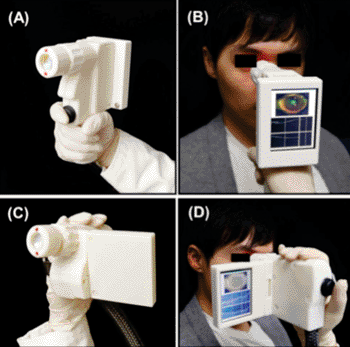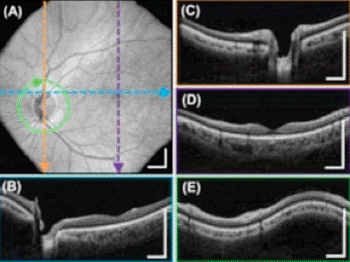New Hand-Held OCT Device to Simplify Early Detection of Retinal Disease
|
By MedImaging International staff writers Posted on 31 Dec 2013 |

Image: Power grip style (A-B) and camcorder style (C-D) designs of the prototype OCT scanner. Both acquire 3D OCT images of the retina (Photo courtesy of Biomedical Optics Express).

Image: A high-definition OCT image of the retina allows clinicians to noninvasively visualize the 3D structure of key regions, such as the macula (region near the fovea) and optic nerve head, to screen for signs of disease pathology. Shown here is a wide field view (A) as well as detailed vertical cross-sections (B-C-D) and a circular cross-section (E) (Photo courtesy of Biomedical Optics Express.)
A novel hand-held optical device quickly scans a patient’s entire retina and so could aid in detecting early signs of a host of retinal diseases, including diabetic retinopathy, glaucoma, and macular degeneration.
A team at the Massachusetts Institute of Technology (MIT; Cambridge, MA, USA) describes their new ophthalmic-screening instrument in a report by Lu, C.D. et al., published by The Optical Society (Washington DC, USA), December 20, 2013, in the journal Biomedical Optics Express. Although others have created hand-held devices using similar technology, the new design is the first to combine cutting-edge technologies such as ultrahigh-speed 3D imaging, a tiny micro-electromechanical systems (MEMS) mirror for scanning, and a technique to correct for unintentional movement by the patient. These innovations should allow clinicians to collect comprehensive data with just one measurement.
Many eye diseases should be detected and treated long before any visual symptoms arise, but few people visit eye specialists regularly. The MIT group, in collaboration with the University of Erlangen and Praevium/Thorlabs, has developed this portable instrument to improve public access to eye care. "Hand-held instruments can enable screening a wider population outside the traditional points of care," said Prof. James Fujimoto, MIT. They can be used at a primary-care physician's office or even in the developing world.
The instrument uses optical coherence tomography (OCT), which sends beams of infrared light into the eye and onto the retina. Echoes of this light return to the instrument, which uses interferometry to measure changes in the time delay and magnitude of the returning light echoes, revealing the cross-sectional tissue structure of the retina, similar to radar or ultrasound imaging. Tabletop OCT imagers have become a standard of care in ophthalmology, and current generation hand-held scanners are used for imaging infants and monitoring retinal surgery. The MIT group turned a typically large instrument into a portable size by using a MEMS mirror to scan the OCT imaging beam. The new device can acquire images comparable in quality to the conventional tabletop OCT instruments used by ophthalmologists.
To deal with the motion instability of a hand-held device, the instrument takes multiple 3D images at high speeds, scanning one particular volume of the eye many times but with different scanning directions. This makes it possible to correct for distortions due to motion of the operator’s hand or the subject’s eye.
The next step, said Prof. Fujimoto, is to evaluate the technology in clinical settings; however, the device is still expensive. "The hand-held platform allows the diagnosis or screening to be performed in a much wider range of settings,” said Prof. Fujimoto. He envisions that in the future hand-held OCT technology can be used in many other medical specialties beyond ophthalmology, such as in applications ranging from surgical guidance to military medicine.
Related Links:
Massachusetts Institute of Technology
The Optical Society
A team at the Massachusetts Institute of Technology (MIT; Cambridge, MA, USA) describes their new ophthalmic-screening instrument in a report by Lu, C.D. et al., published by The Optical Society (Washington DC, USA), December 20, 2013, in the journal Biomedical Optics Express. Although others have created hand-held devices using similar technology, the new design is the first to combine cutting-edge technologies such as ultrahigh-speed 3D imaging, a tiny micro-electromechanical systems (MEMS) mirror for scanning, and a technique to correct for unintentional movement by the patient. These innovations should allow clinicians to collect comprehensive data with just one measurement.
Many eye diseases should be detected and treated long before any visual symptoms arise, but few people visit eye specialists regularly. The MIT group, in collaboration with the University of Erlangen and Praevium/Thorlabs, has developed this portable instrument to improve public access to eye care. "Hand-held instruments can enable screening a wider population outside the traditional points of care," said Prof. James Fujimoto, MIT. They can be used at a primary-care physician's office or even in the developing world.
The instrument uses optical coherence tomography (OCT), which sends beams of infrared light into the eye and onto the retina. Echoes of this light return to the instrument, which uses interferometry to measure changes in the time delay and magnitude of the returning light echoes, revealing the cross-sectional tissue structure of the retina, similar to radar or ultrasound imaging. Tabletop OCT imagers have become a standard of care in ophthalmology, and current generation hand-held scanners are used for imaging infants and monitoring retinal surgery. The MIT group turned a typically large instrument into a portable size by using a MEMS mirror to scan the OCT imaging beam. The new device can acquire images comparable in quality to the conventional tabletop OCT instruments used by ophthalmologists.
To deal with the motion instability of a hand-held device, the instrument takes multiple 3D images at high speeds, scanning one particular volume of the eye many times but with different scanning directions. This makes it possible to correct for distortions due to motion of the operator’s hand or the subject’s eye.
The next step, said Prof. Fujimoto, is to evaluate the technology in clinical settings; however, the device is still expensive. "The hand-held platform allows the diagnosis or screening to be performed in a much wider range of settings,” said Prof. Fujimoto. He envisions that in the future hand-held OCT technology can be used in many other medical specialties beyond ophthalmology, such as in applications ranging from surgical guidance to military medicine.
Related Links:
Massachusetts Institute of Technology
The Optical Society
Latest General/Advanced Imaging News
- AI-Powered Imaging System Improves Lung Cancer Diagnosis
- AI Model Significantly Enhances Low-Dose CT Capabilities
- Ultra-Low Dose CT Aids Pneumonia Diagnosis in Immunocompromised Patients
- AI Reduces CT Lung Cancer Screening Workload by Almost 80%
- Cutting-Edge Technology Combines Light and Sound for Real-Time Stroke Monitoring
- AI System Detects Subtle Changes in Series of Medical Images Over Time
- New CT Scan Technique to Improve Prognosis and Treatments for Head and Neck Cancers
- World’s First Mobile Whole-Body CT Scanner to Provide Diagnostics at POC
- Comprehensive CT Scans Could Identify Atherosclerosis Among Lung Cancer Patients
- AI Improves Detection of Colorectal Cancer on Routine Abdominopelvic CT Scans
- Super-Resolution Technology Enhances Clinical Bone Imaging to Predict Osteoporotic Fracture Risk
- AI-Powered Abdomen Map Enables Early Cancer Detection
- Deep Learning Model Detects Lung Tumors on CT
- AI Predicts Cardiovascular Risk from CT Scans
- Deep Learning Based Algorithms Improve Tumor Detection in PET/CT Scans
- New Technology Provides Coronary Artery Calcification Scoring on Ungated Chest CT Scans
Channels
Radiography
view channel
World's Largest Class Single Crystal Diamond Radiation Detector Opens New Possibilities for Diagnostic Imaging
Diamonds possess ideal physical properties for radiation detection, such as exceptional thermal and chemical stability along with a quick response time. Made of carbon with an atomic number of six, diamonds... Read more
AI-Powered Imaging Technique Shows Promise in Evaluating Patients for PCI
Percutaneous coronary intervention (PCI), also known as coronary angioplasty, is a minimally invasive procedure where small metal tubes called stents are inserted into partially blocked coronary arteries... Read moreMRI
view channel
AI Tool Predicts Relapse of Pediatric Brain Cancer from Brain MRI Scans
Many pediatric gliomas are treatable with surgery alone, but relapses can be catastrophic. Predicting which patients are at risk for recurrence remains challenging, leading to frequent follow-ups with... Read more
AI Tool Tracks Effectiveness of Multiple Sclerosis Treatments Using Brain MRI Scans
Multiple sclerosis (MS) is a condition in which the immune system attacks the brain and spinal cord, leading to impairments in movement, sensation, and cognition. Magnetic Resonance Imaging (MRI) markers... Read more
Ultra-Powerful MRI Scans Enable Life-Changing Surgery in Treatment-Resistant Epileptic Patients
Approximately 360,000 individuals in the UK suffer from focal epilepsy, a condition in which seizures spread from one part of the brain. Around a third of these patients experience persistent seizures... Read moreUltrasound
view channel.jpeg)
AI-Powered Lung Ultrasound Outperforms Human Experts in Tuberculosis Diagnosis
Despite global declines in tuberculosis (TB) rates in previous years, the incidence of TB rose by 4.6% from 2020 to 2023. Early screening and rapid diagnosis are essential elements of the World Health... Read more
AI Identifies Heart Valve Disease from Common Imaging Test
Tricuspid regurgitation is a condition where the heart's tricuspid valve does not close completely during contraction, leading to backward blood flow, which can result in heart failure. A new artificial... Read moreNuclear Medicine
view channel
Novel Radiolabeled Antibody Improves Diagnosis and Treatment of Solid Tumors
Interleukin-13 receptor α-2 (IL13Rα2) is a cell surface receptor commonly found in solid tumors such as glioblastoma, melanoma, and breast cancer. It is minimally expressed in normal tissues, making it... Read more
Novel PET Imaging Approach Offers Never-Before-Seen View of Neuroinflammation
COX-2, an enzyme that plays a key role in brain inflammation, can be significantly upregulated by inflammatory stimuli and neuroexcitation. Researchers suggest that COX-2 density in the brain could serve... Read moreImaging IT
view channel
New Google Cloud Medical Imaging Suite Makes Imaging Healthcare Data More Accessible
Medical imaging is a critical tool used to diagnose patients, and there are billions of medical images scanned globally each year. Imaging data accounts for about 90% of all healthcare data1 and, until... Read more
Global AI in Medical Diagnostics Market to Be Driven by Demand for Image Recognition in Radiology
The global artificial intelligence (AI) in medical diagnostics market is expanding with early disease detection being one of its key applications and image recognition becoming a compelling consumer proposition... Read moreIndustry News
view channel
GE HealthCare and NVIDIA Collaboration to Reimagine Diagnostic Imaging
GE HealthCare (Chicago, IL, USA) has entered into a collaboration with NVIDIA (Santa Clara, CA, USA), expanding the existing relationship between the two companies to focus on pioneering innovation in... Read more
Patient-Specific 3D-Printed Phantoms Transform CT Imaging
New research has highlighted how anatomically precise, patient-specific 3D-printed phantoms are proving to be scalable, cost-effective, and efficient tools in the development of new CT scan algorithms... Read more
Siemens and Sectra Collaborate on Enhancing Radiology Workflows
Siemens Healthineers (Forchheim, Germany) and Sectra (Linköping, Sweden) have entered into a collaboration aimed at enhancing radiologists' diagnostic capabilities and, in turn, improving patient care... Read more




















